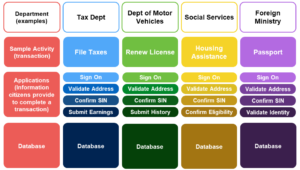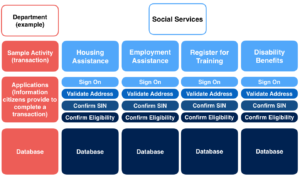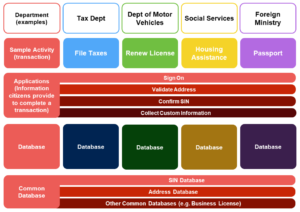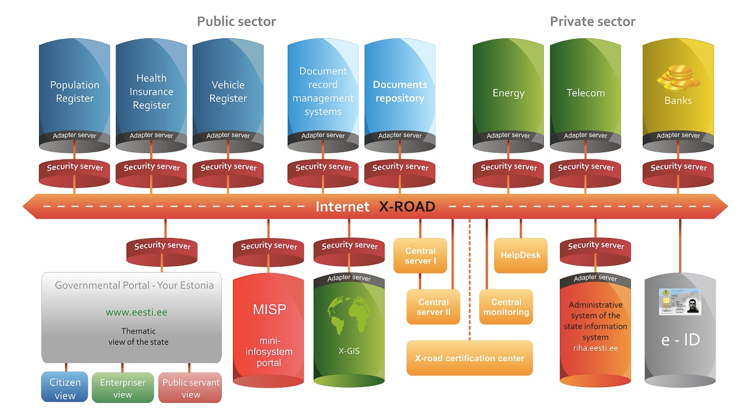
An emerging model of digital government pioneered by Estonia and India is illustrating how governments can do a better job of delivering services. Both countries have devised ways to make it easy for citizens to do simple things online – register a car or renew a passport, for example. But it’s the scalability and flexibility of the systems that sets them apart from the usual way that governments offer these kinds of services.
Most governments have online offerings that were developed from scratch by each department, duplicating rather than leveraging each other’s systems. It’s a siloed approach that misses opportunities for efficiencies and is more expensive than it needs to be.
Estonia and, increasingly India, by contrast, use a standardized system that allows departments and agencies to share sign-in information and databases, which are part of the back-office systems that support online services. In effect, the systems can talk to each other, which means that new services can be developed and offered quickly and cheaply.
This new approach, in which core sets of shared online tools and databases can be leveraged across government agencies, is called platform government.
The approach has captured the imagination of a Canadian parliamentary standing committee on information, privacy and ethics, which will investigate the topic this spring.
It is thus a timely moment to re-examine where digital government is today, look at what new digital approaches are emerging and take a closer look at how one nation – Estonia – has found powerful advantages in adopting such an approach.
Where is digital government today?
In most governments, departments deliver services online, in person or over the phone using expensive, vertically segregated back-office systems. Each service relies on its own large software system that manages a process – filing your taxes, for example, or applying for a driver’s license. A record of each transaction is stored in a distinct database: your tax file, say, or the history of your driver’s license and number. For the last several decades, building these systems has been the core strategy of e-government, initially to automate back-office work, and then as a means of offering services online. The software codified business processes, allowed for a reduction in staffing, and served to standardize service, while databases replaced filling cabinets.
Most often, these systems of software and databases are highly customized – or even custom built. However, the processes used for most government services have much in common. For example, to transact with government, citizens generally need to engage in a number of common activities: sign on and validate who they are, confirm their home and/or work address, note their type of work, define their residency status, etc. (See Fig.1) But because departments digitize their services and functions independently, they duplicate the efforts of other departments in gathering all this information. It’s an inefficient, expensive approach, with information being siloed, and with few standards between systems.
Figure 1
What government looks like today, digitally
Source: David Eaves
Unfortunately, the duplication occurs not only between departments but often within departments as well, as Fig. 2 shows.
Figure 2
Duplicating IT even within departments
Source: David Eaves
There are good reasons why IT systems evolved this way. It required almost no coordination across government to develop piecemeal systems, consolidation brings different types of privacy and security risks, and, once in place, it was hard and expensive to reform. But the short-term benefits have impeded the creation of a shared public, digital government infrastructure. That has real costs.
Government departments reinvent the wheel over and over again as they deploy services that store virtually identical information. For example, there is significant overlap in processes and the information governments collect to register a car, renew a passport or apply for a health- care card. Citizens often face a confusing array of websites, making it less likely they’ll want to use them again. And, of course, these systems evolve slowly (if ever), making innovation risky and hard if not nearly impossible.
Canada’s approach is akin to a poorly planned highway system that’s nearly impossible to expand. Say, for example, the highway from Vancouver to Calgary existed without a turn-off for Banff, but adding an off-ramp would be so difficult or expensive that it would be better to build an entire new highway running parallel most of the way except for the last few kilometres. This is what the government’s system of online offerings favours. The systems that enable the offerings can’t be easily leveraged to work in tandem with other offerings. Highways work because with a few simple standards, we’ve made a highway network that allows us to add new routes. The system of digital platforms is bringing a similar approach to government services.
A portrait of the future, today
Estonia and India are two countries leading the way in rethinking the very idea of government digital infrastructure. They are not simply increasing broadband connectivity so that online services work faster and that more people, no matter where they live, can access services on the go, although those issues matter deeply. They are defining standards so that the core sets of public tools and databases – the platforms – can be reused by the public and private sector to drive down costs and simplify services. They see government platforms as core public infrastructure and a source of competitive advantage. What does this vision look like? Frequently it starts with shared a set of databases and applications for departments across the public sector. (See Fig. 3)
Figure 3
A vision of digital government
Source: David Eaves
This can seem far-fetched given the complexity of our governments, but Estonia is on the leading edge for shared information with its X-Road system (Figure 4). Estonian departments and private-sector utilities (e.g., energy, telecom, banks) maintain independent databases but enable other public government institutions to securely access them. Citizens can use a single password to access different government websites to see their medical records or insurance history. Critically, agencies get to share data, and people avoid the hassle of re-entering their passwords for each government agency. Indeed, by law in Estonia, the government can only ask citizens once for each piece of information. When one agency collects information on someone – say an updated home address – it is updated in a centralized database that all agencies use. In this scenario, it would be a database dedicated to storing home addresses. This is akin to updating your address on your tax form, and having every other government department be aware of the new address within seconds. Critically, there is a mechanism for citizens to see who has accessed their data to ensure no one is doing so without proper authority.
But the real innovation here is that to build a new service, governments need only connect to existing databases, and take the data they need to build the “last mile” to the user. Services can be created faster and more efficiently, all while leveraging the underlying layers of databases and applications – just like off-ramps and access roads make use of the highway system instead of another highway having to be built from scratch. Building the core infrastructure is no easy task – but the upshot is that getting it right can create huge benefits: better, more flexible services at dramatically reduced cost.
Figure 4
X-Road: Estonia’s shared cross-sector data infrastructure
Source: e-estonia.com
Of course, Estonia is not Canada. It has 1.3 million citizens, a less diverse population and a distinct historical context: The Soviet withdrawal created a “greenfield” that allowed a reimagining of government without the burden of legacy IT systems and processes. What works in that environment might not work in Canada. For a similar government platform approach to take hold in the Canadian public sector, there are complex challenges that will have to be addressed. Happily, there are indications that the concept is being embraced. The Canadian government’s new directive on management of information technology shows that civil servants not only recognize the urgency and benefits of a coordinated approach to digital government, they’re developing the organizational sinews that could make platforms possible.
In particular, national digital standards have begun to apply to the use of APIs (application programming interfaces, the tools that software developers use to create software). This will enable different agencies to access information about citizens to reduce duplication each time a service is built or used.
The road ahead
There are challenges ahead for such an approach. Canadian public servants are still recovering from challenges associated with the rollout of national shared services and other IT debacles. At a minimum, a new effort is likely to face skepticism and pushback in Canada at the very moment that other nations are accelerating their efforts. This could put Canada at a competitive disadvantage as countries that invest in e-service networks will have a huge opportunity to deliver services at a much lower cost.
The risks and concerns are real. Before anyone rushes into the future, the standing committee needs to consider the deeper challenges that come with a shift to a platform approach to government. There are at least four:
- The future could break the social contract between government and citizens: Seamlessly linking data across departments opens up complex questions about privacy, anonymity and trust.
- Whoever controls the servers will control the government: Departments and leaders who control these shared services could have de facto power to deny access to parts of systems and control how they are developed. This includes downstream actors like sub-jurisdictions or private-sector companies that depend on the platforms for information.
- Whoever owns services shapes the future: Departments – or equally likely, private software vendors who play a role in building systems – will determine the architecture of services and offerings, and could design them to impede competitors or constrain offerings in certain ways. Vendors are often tempted to offer services that “lock-in” clients, making it hard for them to switch providers or use competitors. Given how central some of these systems could become to government operations, such risks could have a wide impact.
- Siloed Parliament meets shared platforms: What will accountability look like for shared services in a government system built around siloed ministries? How will we enable public servants and the public to trust common platforms particularly in light of recent debacles in shared services and the bungled Phoenix pay-system roll-out?
If the government is serious about digital transformation, we will need online systems that tackle the problems and profit from the opportunities of the 21st century. But most critically it requires deep and serious thinking about ways to offer services online and a plan to build public buy-in and trust to ensure these new tools create opportunities without undermining public confidence in our critical institutions. Moreover, while building this new infrastructure will be difficult, the real challenge is likely in finding the right governance models. Parliamentary systems tend to divide responsibility across ministries, but shared platforms challenge this approach and could require new thinking to ensure they are effective and trusted.
This article is part of the Wiring Public Policy for Digital Government special feature.
Photo: Shutterstock by Dmitry Tkachenko Photo
Do you have something to say about the article you just read? Be part of the Policy Options discussion, and send in your own submission. Here is a link on how to do it. | Souhaitez-vous réagir à cet article ? Joignez-vous aux débats d’Options politiques et soumettez-nous votre texte en suivant ces directives.















